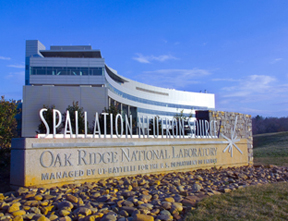The Spallation Neutron Source at Oak Ridge National Laboratory in Tennessee has opened a neutron beamline dedicated to the study of the neutron itself. This close neighbor of the proton may hold clues to the nature of the early universe, matter's triumph over antimatter and other compelling questions; the new Fundamental Neutron Physics Beamline is dedicated to digging them out.
An article in Physics World neatly sums it up:
Neutrons are, of course, neutral. But the FNBP will be able to examine whether, for example, the charged quarks inside neutrons give the particle a slight dipole. Such a dipole could help explain why the universe is almost solely made from matter and not antimatter. The FNBP will also look into the decay of free neutrons — which bound in nuclei are normally quite stable — to clarify the distribution of elements shortly after the Big Bang. Finally, the the FNBP will measure the interactions between neutrons and nuclei, hopefully to shed light on so-called symmetry violation — a concept that was first outlined theoretically by Yoichiro Nambu, joint winner of this year’s Nobel Prize for Physics.
And from the Oak Ridge press release:
"While other beam lines use neutrons as a probe to study materials, the object for much of the work proposed at the FNPB is the study of the neutron itself," said University of Tennessee Professor Geoffrey Greene, who holds a Joint Faculty Appointment with ORNL and who leads the FNPB project. "Among the questions that will be addressed at the FNPB are the details of the internal structure of the neutron as well as a careful study of the way in which the free neutron decays. Such experiments have important implication for fundamental questions in particle physics and cosmology."Greene explained that neutrons, which have no electric charge, may nevertheless have a slight displacement between internal positive and negative charges. The existence of such a "neutron electric dipole moment" could shed light on what happened in the early phases of the Big Bang. In particular it could help to explain why the universe appears to be made entirely of matter without any antimatter, he said.
While the neutron is stable in most nuclei, when it is liberated (for example in an SNS neutron beam) it lives for only about 10 minutes. "Precise measurements of the neutron lifetime help clarify the distribution of chemical elements generated in the first few minutes of the Big Bang and shed light on the amount of normal matter—as opposed to dark matter and dark energy—in the universe," Greene said.
"Another set of extremely precise studies at the FNPB will address the interaction between neutrons and simple nuclei and may help to explain universal 'parity' violation," Greene said. "Roughly speaking, parity is the symmetry that implies that the laws of physics are invariant when 'viewed in a mirror.' The surprising fact is, at a basic level, the universe appears to be 'left-handed.'
"The challenge remains to understand why this puzzling state of affairs exists," he said.
It's good to know, in this rancorous election year, that neutral does not equal dull!







